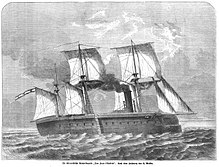SMS Juan d'Austria
SMS Juan de Austria was a 2nd class tank frigate of the Austrian Navy in the 19th century. The ship was named after Juan de Austria (1547–1578), the winner of the naval battle of Lepanto in 1571. Sister ships were the Kaiser Max (the type ship, 1862) and the Prinz Eugen (1862). The three ships were a further development of the Salamander class, larger and with more powerful armament. They were made of wood but had iron belt armor .
Construction and technical data
The Juan de Austria was in 1862 at the Cantiere a San Marco in Trieste from the stack . It was 70 m long, displaced 3,650 tons , and had three masts and a chimney. The machine developed 650 hp and allowed a top speed of 11.4 knots . The belt armor was 110 mm thick. The ship was armed with 16x48 pounders (smooth barrel), 15x24 pounders (drawn barrel), 1x12 pounders and 1x6 pounders. The crew consisted of 386 men in 1866. The main armament was replaced by 12x17.8-cm guns in 1867.
Calls
The three ships proved to be comparatively unseaworthy because of their open bow , in which a casemate gun was located, and therefore had to be rebuilt in 1867. Nevertheless, the Juan d'Austria took part in the German-Danish War in the North Sea in 1864 and in the naval battle at Lissa on July 20, 1866 . There she drove in Rear Admiral Tegetthoff's wedge-shaped battle order directly to the left behind the flagship Archduke Ferdinand Max . Her sister ships Kaiser Max and Prinz Eugen were the two wing ships of the first wedge. The Juan d'Austria fired a total of 277 rounds in the battle, received 41 hits, and suffered one dead and four wounded. Liner captain (captain of the sea) Anton von Wiplinger was awarded the Knight's Cross of the Order of Leopold after the battle .
New building as Don Juan d'Austria
The wood of the three ships was soon so rotten that they could no longer be used. However, since it was easier to get funds for repairs than for new buildings, the Juan d'Austria and the Kaiser Max were sent to the STT shipyard and the Prinz Eugen to the naval shipyard in Pola in December 1873 . From there they came back in the years 1876–1878 after "repairs" as practically completely new casemate ships. Only their machinery, equipment and armor were reused. The Juan d'Austria was given the new name Don Juan d'Austria , while her sister ships kept their previous names.
The Don Juan d'Austria now had an iron hull, was 75.9 m long and 15.24 m wide, had a 6.15 m draft and displaced 3548 tons. The iron belt armor was 8 inches thick and stretched the entire length of the ship; the casemate armor was 12.5 cm thick. The maximum speed was now 13.3 knots. The armament consisted of eight 21-cm guns, four 90 mm guns, two 70 mm guns and six 47mm rapid-charging guns and three 47mm machine guns and two 25 mm machine guns . There were also four 35-cm torpedo tubes in the bow. The crew now numbered 400 men.
The ship served in the fleet until 1904, then was used as a residential ship and finally sunk in 1919.
Honor
The rear flag of Juan d'Austria , which she wore near Lissa, hangs in the Army History Museum in Vienna today .
literature
- Tony Gibbons, The Complete Enzyclopedia of Battleships , Crescent Books, Crown Publishers, New York, 1983, ISBN 0-517-378108 (pp. 36 & 88)

